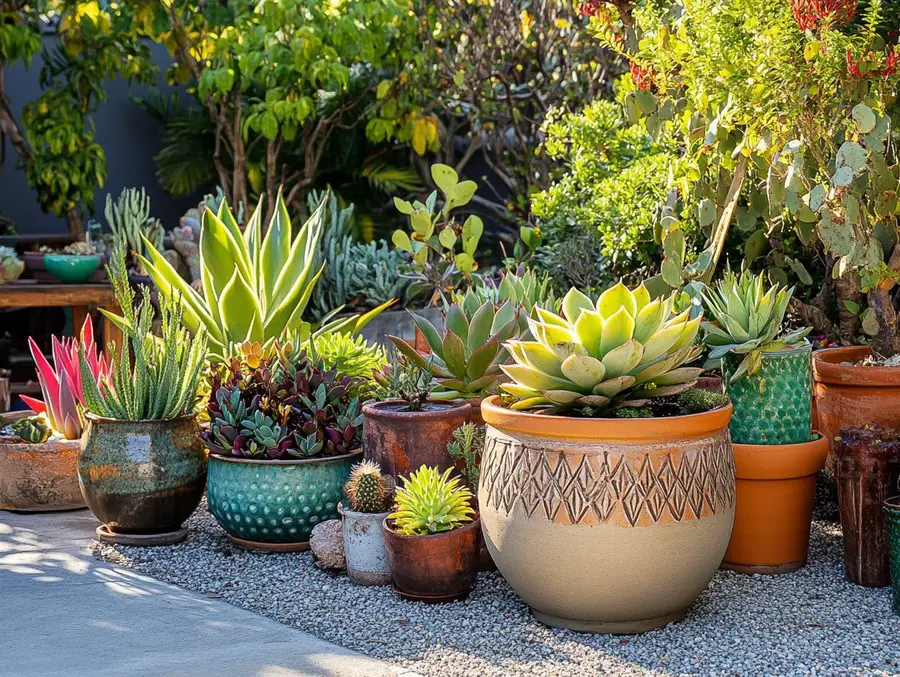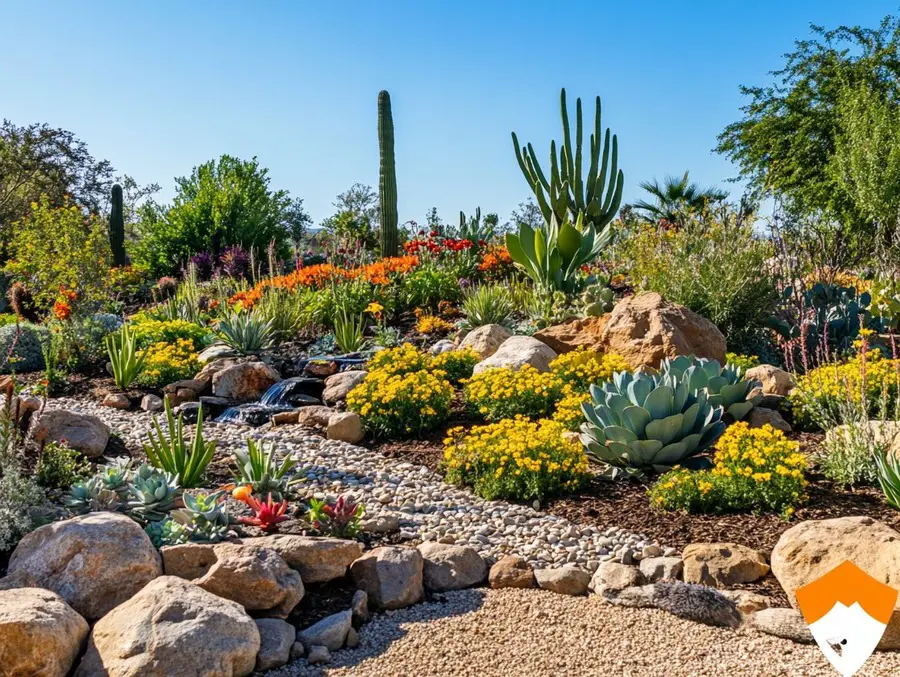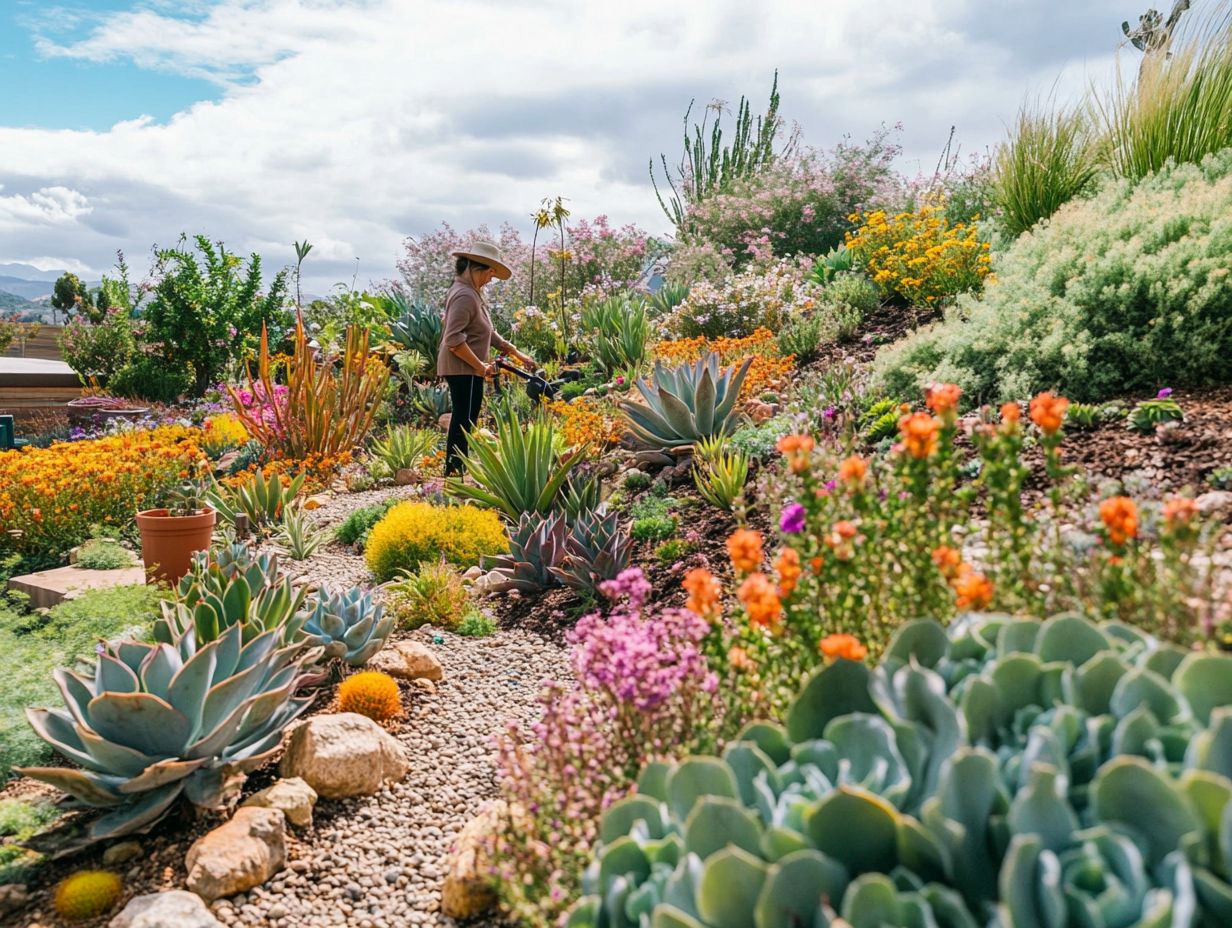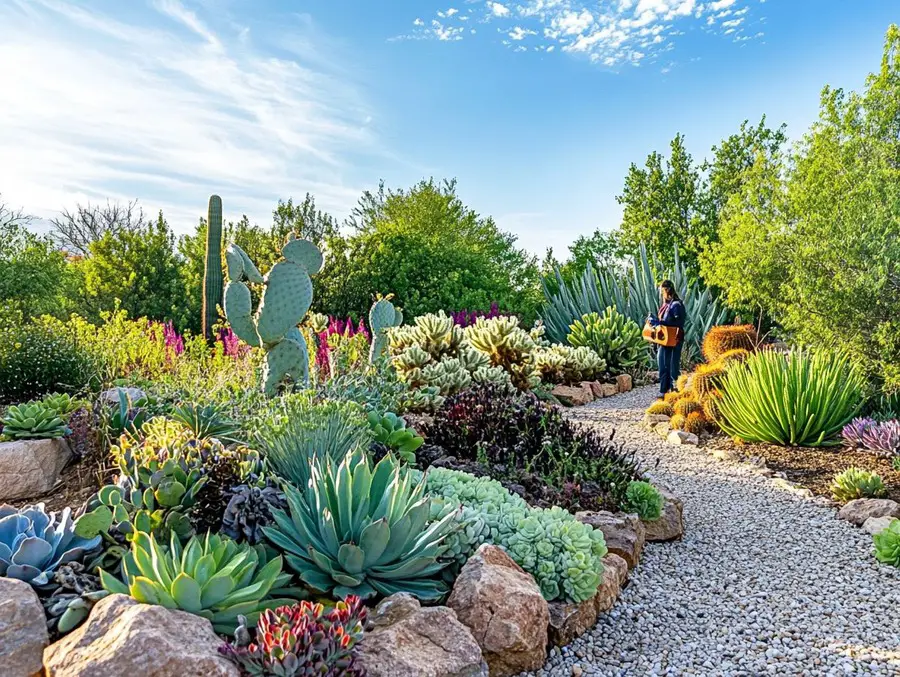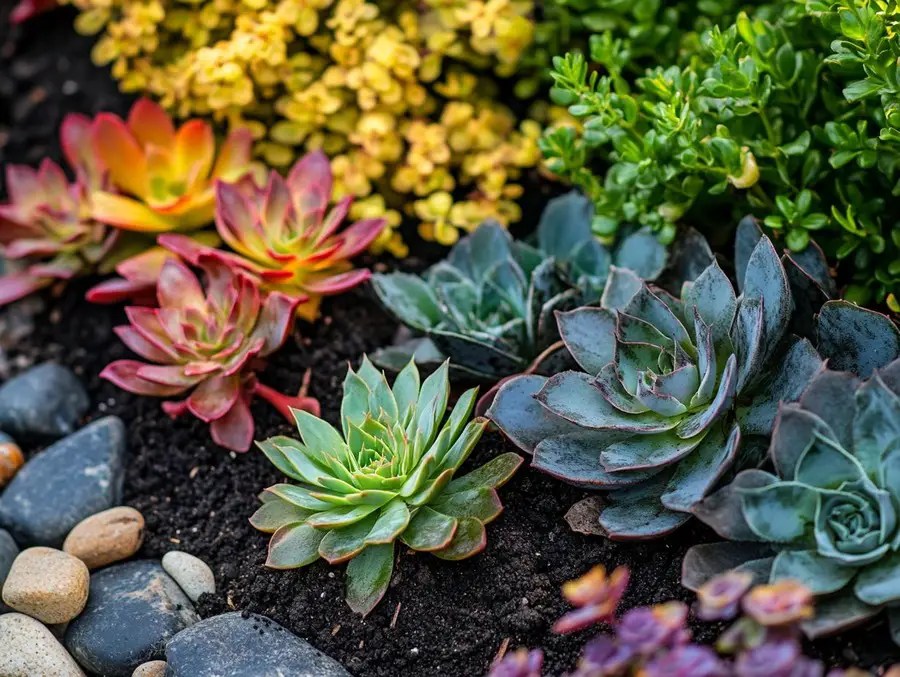We use affiliate links. If you purchase something using one of these links, we may receive compensation or commission.
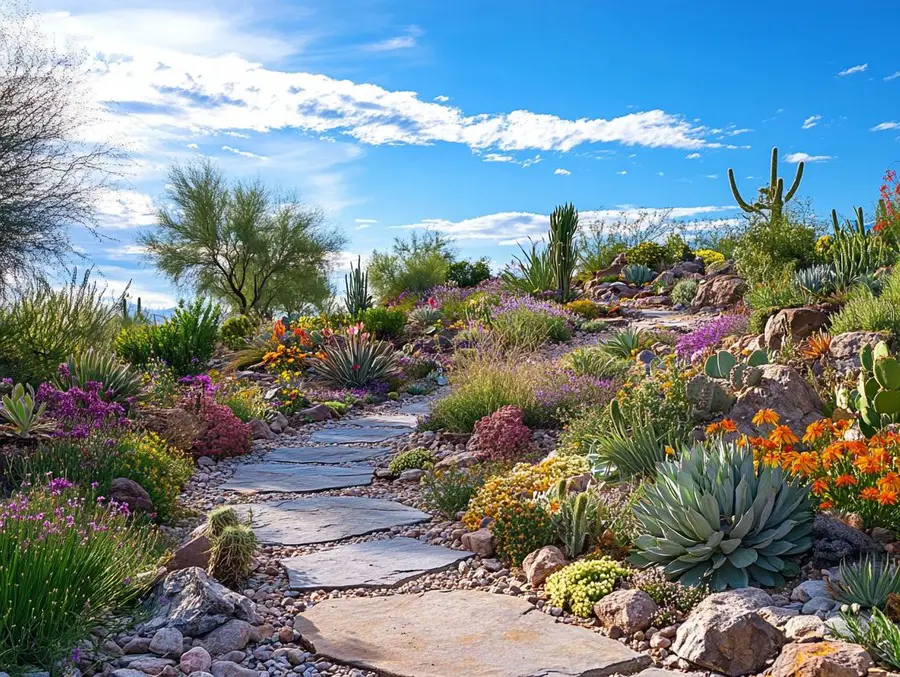
Native Plants for Xeriscaping are the key to creating a low-maintenance, water-efficient garden that thrives in your local climate.
Struggling with high water bills or plants that just won’t survive dry conditions?
By using native species, you’ll conserve water, support wildlife, and enjoy a lush, vibrant landscape with minimal effort.
Let’s explore the best options for your xeriscape!
Native Plants for Xeriscaping
Key Takeaways
- Native Plants for Xeriscaping are drought-tolerant species adapted to local climates, reducing water use and maintenance.
- These plants support biodiversity, enrich soil health, and thrive with minimal irrigation.
- Choosing region-specific flora helps create a sustainable, eco-friendly landscape that conserves resources while providing a habitat for pollinators and wildlife.
Native Plants for Xeriscaping: Water-Wise Landscaping Tips
Xeriscaping is a sustainable landscaping approach that helps you save water by using drought-resistant plants and smart design techniques.
This method brings native plants into the mix and can turn your garden into an eco-friendly oasis.
You’ll find tips for designing and maintaining your xeriscape, along with a rundown of common misconceptions that might be holding you back.
Get ready to uncover the secrets to creating a beautiful, low-water landscape that looks great but also helps the environment!
What is Xeriscaping?
Xeriscaping is a landscape design approach that focuses on water conservation by using drought-resistant and native plants.
This way, you can create beautiful, low-maintenance gardens that work well in different climates.
This method helps maintain ecological balance, and it also encourages sustainable gardening practices, which are super important in areas that deal with drought.
By adopting xeriscape principles, you can boost the health of local ecosystems while enjoying a vibrant outdoor space that needs less watering and upkeep.
It’s a win-win for being eco-friendly and saving some cash!
Explanation and Benefits
The benefits of xeriscaping go way beyond just looking good.
You’ll find it offers some serious perks like better soil health, enhanced biodiversity conservation, and effective erosion control, all while making sure your garden manages water efficiently.
By using native plants that thrive in your local climate, you can promote healthier soil ecosystems.
These plants usually need less water and fertilizer, which means you can cut back on chemical inputs that could harm nearby habitats.
Interestingly, studies show that gardens designed with xeriscaping techniques can slash water usage by up to 50%.
This approach creates essential habitats for various pollinators and wildlife, helping to foster a thriving ecosystem.
By adopting these practices, you’re not just doing your garden a favor.
You’re also contributing to a sustainable environment and fighting climate change by reducing water waste and soil degradation.
Choosing Native Plants for Xeriscaping
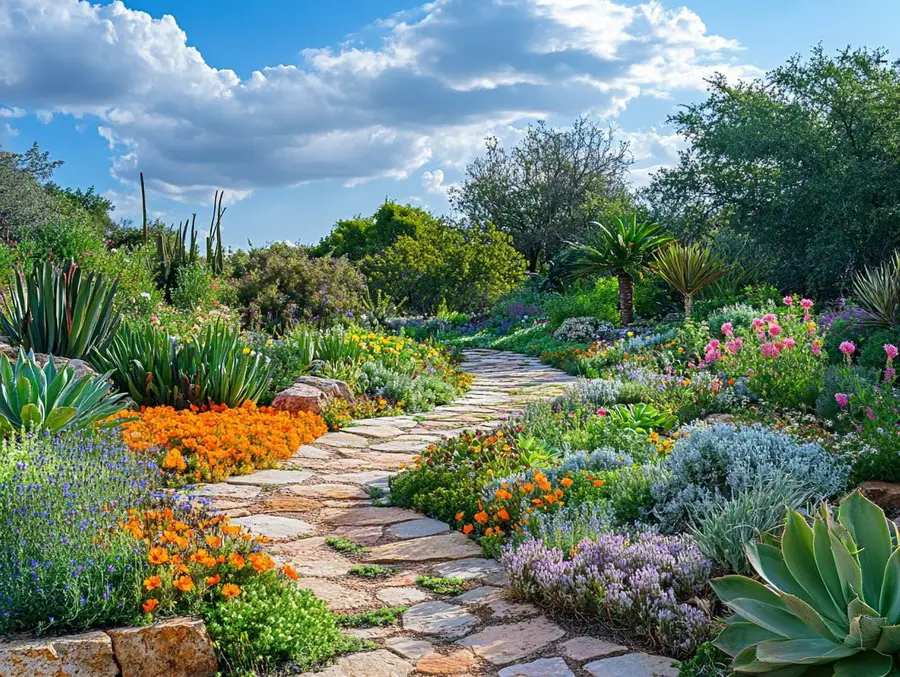 When you’re picking native plants for xeriscaping, it’s important to think about the specific conditions in your area, like the climate, soil type, and the natural flora around you.
When you’re picking native plants for xeriscaping, it’s important to think about the specific conditions in your area, like the climate, soil type, and the natural flora around you.
This way, you can make sure your choices fit with the principles of sustainable gardening and help create a diverse and resilient landscape.
Factors to Consider
When you’re choosing native plants, it’s crucial to think about their climate adaptation, how well they handle local conditions, and their ability to thrive with minimal water.
You’ll want to keep an eye on invasive species that could mess with your xeriscape garden.
One major thing to consider is how well these plants retain soil moisture.
This helps them survive during dry spells and promotes healthier ecosystems overall.
Selecting plants that naturally fit in with the local flora and fauna creates a balanced environment, providing habitats for wildlife and ensuring that your garden gets pollinated.
By incorporating native species, you can help reduce the spread of invasive plants that often outcompete the local vegetation, which is key to preserving biodiversity.
This thoughtful approach boosts plant resilience and highlights the importance of practical, sustainable gardening practices that work in harmony with the local ecosystem.
Benefits of Using Native Plants
Using native plants in your xeriscaping efforts brings a ton of benefits.
You’ll be contributing to environmental sustainability, boosting biodiversity, and supporting local wildlife.
It’s a fantastic choice for anyone who cares about being eco-conscious in their gardening!
Environmental and Economic Advantages
The environmental and economic benefits of using native plants for xeriscaping are pretty impressive.
They boost soil health and support local ecosystems, but they also help you save money by cutting down on water usage and maintenance costs.
By adopting xeriscaping practices, you can seriously lower your water bills since these drought-resistant landscapes need way less irrigation than traditional gardens.
Investing in xeriscaping often leads to reduced maintenance expenses, too, because native plants are typically hardier and require fewer resources to keep them looking good.
Making the switch to sustainable gardening helps the planet and enhances local biodiversity, creating homes for important wildlife.
Embracing xeriscaping is a smart move that blends saving money with being environmentally responsible, resulting in healthier outdoor spaces that can thrive even in tough climate conditions.
Best Native Plants for Xeriscaping
When you’re choosing the best native plants for xeriscaping, it’s a good idea to think about mixing in a variety of species.
Look for native shrubs, ornamental grasses, and succulents that can thrive in those dry conditions.
They look great, and they also bring some awesome ecological benefits to your landscape.
Examples and Characteristics
When you’re looking to xeriscape, there are some fantastic native plants to consider, especially those drought-tolerant species like native wildflowers and xerophytes.
Each of these plants brings its own unique flair to your landscape, enhancing both its visual appeal and ecological function throughout the seasons.
Take the vibrant desert marigold, for example. It shows off bright yellow blooms in the spring, drawing in pollinators while its silvery leaves reflect sunlight, helping with heat resistance.
Then there’s the prickly pear cactus, which isn’t just a tough cookie in dry conditions.
It also produces stunning magenta flowers and tasty fruits that are a hit with local wildlife.
And let’s not forget the agave plant, which really stands out with its striking architectural shape.
It thrives in harsh conditions, thanks to its thick, fleshy leaves that store water.
These native species keep things interesting with their seasonal blooms and foliage changes, and they also play a big role in boosting biodiversity by providing habitats and food for various insects and animals.
Designing a Xeriscape Garden
When you’re designing a xeriscape garden, it’s important to get a grip on sustainable landscape practices and effective xeriscaping techniques.
This means thinking about where to strategically place low-maintenance plants, incorporating rain gardens, and using mulch to help retain soil moisture and keep those pesky weeds at bay.
Tips and Techniques
When you’re setting up your xeriscape garden, focus on effective tips and techniques like maximizing irrigation efficiency, picking the right native plants, and using adaptive landscaping methods that boost soil health and plant resilience.
Don’t forget about mulching strategies and timing your irrigation to the cooler parts of the day to help with water retention.
Regularly checking soil moisture can really amp up your irrigation efficiency, cutting down on waste and encouraging those deep roots to grow.
Seasonal care is key, so make sure you’re pruning and fertilizing when it counts to help your native species thrive all year long.
By using companion planting techniques, you can create a healthy ecosystem that attracts beneficial insects and pollinators, making your garden more sustainable.
Understanding your local climate conditions can help you choose drought-resistant plants, giving your xeriscape a sturdy edge overall.
Maintaining a Xeriscape Garden

To maintain a xeriscape garden, you need to wrap your head around some key practices.
This includes knowing the proper watering guidelines, when to prune, and how to tackle soil erosion.
By doing this, you can keep your landscape healthy and vibrant without putting in too much effort.
Watering and Pruning Guidelines
Watering and pruning guidelines for your xeriscape garden are key to getting the most out of your irrigation and keeping those drought-tolerant species healthy and thriving in their environment.
To really nail it, you should stick to a schedule that minimizes evaporation while maximizing soil moisture retention.
Watering in the early morning or late afternoon is often the way to go; this gives the water a chance to soak deep into the soil before the day’s heat kicks in and causes it to evaporate quickly.
Don’t forget about organic mulch! Tossing some around your plants conserves moisture and keeps those pesky weeds at bay, so they aren’t fighting for resources.
Regarding pruning, focus on the growth patterns of each plant.
A little knowledge goes a long way, and recognizing the right time and technique can really help maintain your plants’ vigor.
And hey, checking out local native plant nurseries can be a game changer.
They offer great selections that are well-suited to your local climate, which can boost the overall success of your xeriscape garden.
Common Misconceptions about Xeriscaping
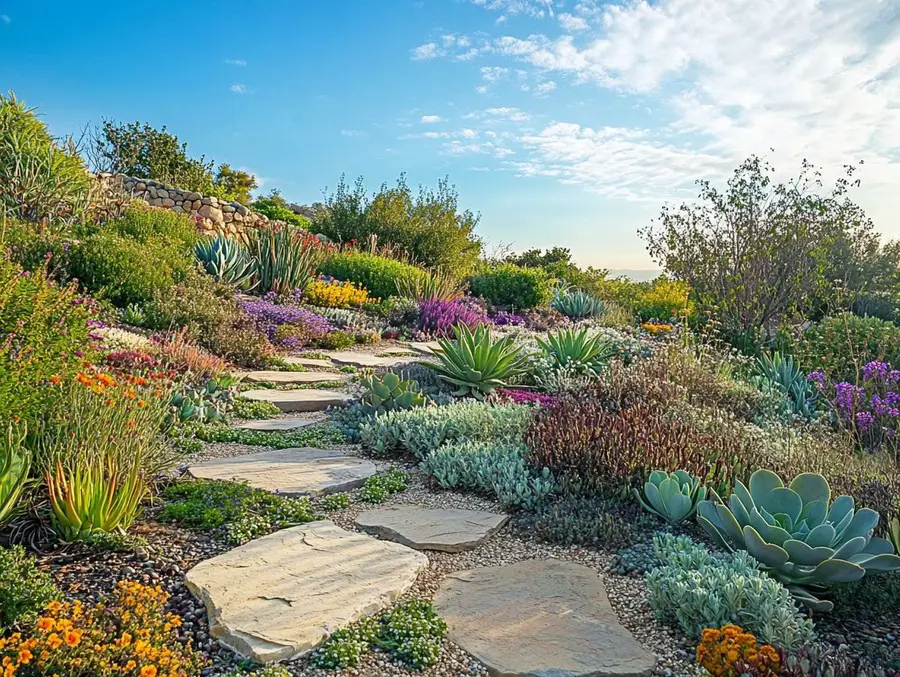 You might have heard some common misconceptions about xeriscaping that make it hard to jump on the sustainable gardening bandwagon.
You might have heard some common misconceptions about xeriscaping that make it hard to jump on the sustainable gardening bandwagon.
One of the biggest myths is that xeriscaping results in dull, lifeless landscapes.
The truth is, it can actually transform your yard into a vibrant, eco-friendly garden bursting with life and color.
Don’t let those misconceptions hold you back from creating a beautiful and sustainable outdoor space!
Debunking Myths and Misunderstandings
Debunking myths and misunderstandings about xeriscaping is essential for promoting its environmental sustainability and highlighting the biodiversity benefits of using native plants in your garden design.
You might think that xeriscaping leads to barren, lifeless landscapes, but that couldn’t be further from the truth.
This innovative landscaping method actually uses a diverse range of drought-resistant plants that thrive in local climates while providing vital habitats for wildlife.
By incorporating native species, your garden can conserve water and become a vibrant ecosystem that attracts pollinators like bees and butterflies.
Xeriscaping reduces the need for chemical fertilizers and pesticides, which can be harmful to the environment.
So, getting to know the true potential of xeriscaping can really shift your perspective and encourage more environmentally responsible gardening practices.
Frequently Asked Questions
What are native plants?
Native plants are plants that are indigenous to a particular region or ecosystem.
They have evolved to thrive in a specific environment and are well adapted to the local climate, soil, and wildlife.
What is xeriscaping?
Xeriscaping is a landscaping method that uses drought-resistant plants and efficient irrigation techniques to conserve water and create a sustainable and low-maintenance landscape.
Why should I use native plants for xeriscaping?
Native plants are ideal for xeriscaping because they are already adapted to the local climate and require less water and maintenance compared to non-native plants.
They also provide important habitats for native wildlife.
What are some examples of native plants for xeriscaping?
Some examples of native plants for xeriscaping include cacti, succulents, ornamental grasses, wildflowers, and shrubs like sage, yucca, and agave.
It is best to choose plants that are native to your specific region.
How do I incorporate native plants into my xeriscaping design?
When designing your xeriscaping, consider the natural layout of your landscape and choose plants that will thrive in each specific area.
Group plants with similar watering needs together, and use mulch to retain moisture and reduce weeds.
Plant in layers to create a diverse and visually appealing landscape.
Do I need to water native plants for xeriscaping?
While native plants are more drought-resistant than non-native plants, they may still need supplemental watering during periods of extreme drought.
It is important to choose plants that are well-suited to your local climate and to water them deeply and infrequently to encourage deep root growth.
Best Plants for Xeriscape Gardens: Hardy & Beautiful
Xeriscape Garden Styles: Easy Low-Maintenance Options
Xeriscape Gardening Techniques: Easy Low-Water Tips
Xeriscape Garden Design & Layout: Easy Water-Wise Beauty
What is xeriscaping? A beginner’s guide to drought-tolerant landscaping – Colorado State University
Related Content
Visit my Amazon Influencer Page for videos and gardening products Grow Your Own Garden

